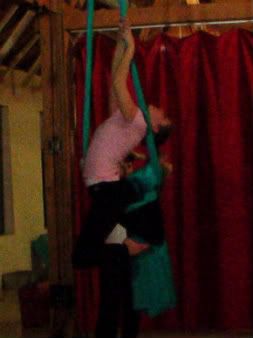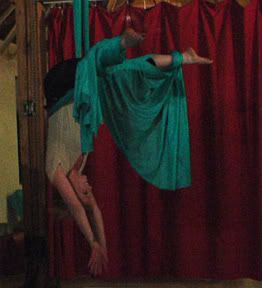Sunday, April 27, 2008
Curtain Call
If you are curious to the perpetrator behind stinky ballerina feet, or the reason why you witnessed my missing toenail (cough Marcus)...
Then take a seat and visit my site about Pointe Shoes.
These objects of torture allow dancers to float across the stage, but they don't feel as pretty as they look. This site is dedicated to helping dancers find a shoe and foot care that helps them dance more comfortably. It was created to give a sneak peek into the world of dance for audiences who are watching ballet for the first time.
Enjoy! and feel free to leave a comment or two here after the show!
Sunday, April 13, 2008
Shoes
Although I enjoy all forms of dance, much of my balance and strength came from my ability to dance on the tippy tips of my toes. Because the idea of seeming weightless is so important to the technique and made possible by the great evolution of what we call pointe shoes, an in-depth explanation of pointe shoes and how they work is at hand.
The project will include diagrams of the composition of a pointe shoe, maps including stores that sell them, interviews with dancers and instructors about foot care and shoe fitting, and of course, much media depicting pointe shoes at work. (and perhaps a disclaimer for anyone with a weak stomach, who can't handle missing toenails).
Tuesday, March 25, 2008
Ugly Toes
Old
New Revised version of the entry, including my changes. (Someone made different changes after me, but this still includes my changes).
The first entry didn't have links back to other wiki entries for words such as sylph and ballerina. I don't know about you, but if I weren't a dancer, I would know what a sylph is. So I figured a hyperlink back to the definition of it would be kinda helpful in describing the allure that pointe shoes bring characters who dance on them.
The next edit I made was a little footnote to clarify the word shank. I mean shank is a word that shares many meanings:
It could be a weapon, a poor golf shot, a cut of meat, a bird, part of a ship's anchor... and so on. But none of these give any indication to what part of the shoe it is, (unless you use my shoe as a weapon if you throw it at someone). So I found the Wiki entry for shank, found the ballet definition and added it along with a footnote.
Sunday, March 9, 2008
Heels Over Head
What else does it take to get through a class you might ask? The proper balance between flexibility and strength.
The beginners classes are suited for beginners or for students who are experienced and need a strengthening regime, while the advanced class caters to more serious artists. But despite the level, body type or physical shape of a student, Gavre said the classes are suitable for anybody and any body type. There is even a specific class on Tuesday nights for men who wish to make functional use of their muscles and stretch out to gain flexibility.
Click here for more information on classes, schedules and instructors for Cirque School.
For more information on the venue and location click here.
Sunday, February 24, 2008
Poll Dancing
Tuesday, February 19, 2008
They Can-Can Dance.
A crowd of dancers gathered in front of Sophie's Dance Studio on February 16.
They took a number, they signed papers, they warmed up, they stretched.
They came to dance.
The auditions offfered the opportunity for choreographers and dancers to express individuality and their style of choice: hip-hop, burlesque, contemporary, tap, modern and can-can.
For more info on the upcoming show visit the LA Unbound website.
Sunday, February 10, 2008
Breakin'
Sunday, February 3, 2008
Dancin' the Blues


Sunday, January 27, 2008
White land, Colorful music
Boom ching ching, boom ching ching. If you know traditional Mexican music, you know the tune well. It is the sound of heritage, a celebration of folklore...and a repetitive repeating redundant beat.
But Saturday at El Pueblo in Downtown L.A., a dance company was dancing a different tune. Dancers in long vibrant skirts wove patterns with their arms and told stories with their feet, this time to a blend of musical influences.
I caught up with the director of the Tierra Blanca Dance Company, Blanca Soto and her husband Gerardo Gutierrez, artistic director, to find out what their unique ingredient was.
What does the company name signify?
Soto: My husband lived close to these two mountains in
What type of dance do your students perform?
Soto: We try to combine different types to understand
How much do you charge for class?
Soto: It varies. The YMCA proposed that the kids can use all their services for the $20 membership fee. It’s great, so the kids can take class twice a week and be members of the YMCA. For twice a week, 45 minutes a class, the fee is $20 [a month.] For 90 minutes, twice a week, its $35.
Why do you teach?
Soto: I think the excuse is dancing. Really our motive is to get them involved with the arts. This is another door to see life in a different way, to provide options.
We take them to high caliber performances like Wicked, to see the Nutcracker and get inspired. To identify with other Hispanics and see that they can be on stage as well. We try to get them involved in community service at the hospital and perform at a convalescent home for older people, to appreciate life.
What is important for a dancer to know?
Soto: It is important that everybody knows the basics, ballet technique, the mother of all dances. But you also need to take several techniques to become yourself in expression and to find your own way. You have all these tools and now you can build yourself as a dancer. The most important thing is to understand what you are going to express to the audience, because in that way, you are not just a dancer, you are a performer.Soto demonstrates a contribution to the arts through tradition and culture. She said her goal is to get the kids off the streets and develop confidence in themselves.
To get your own taste of their style check out a class or future performance.
Tierra Blanca offers classes, at the Huntington Park YMCA, to students ranging from 3 years old to adults. More information on classes and performance dates can be found at the Tierra Blanca Arts Center website.



